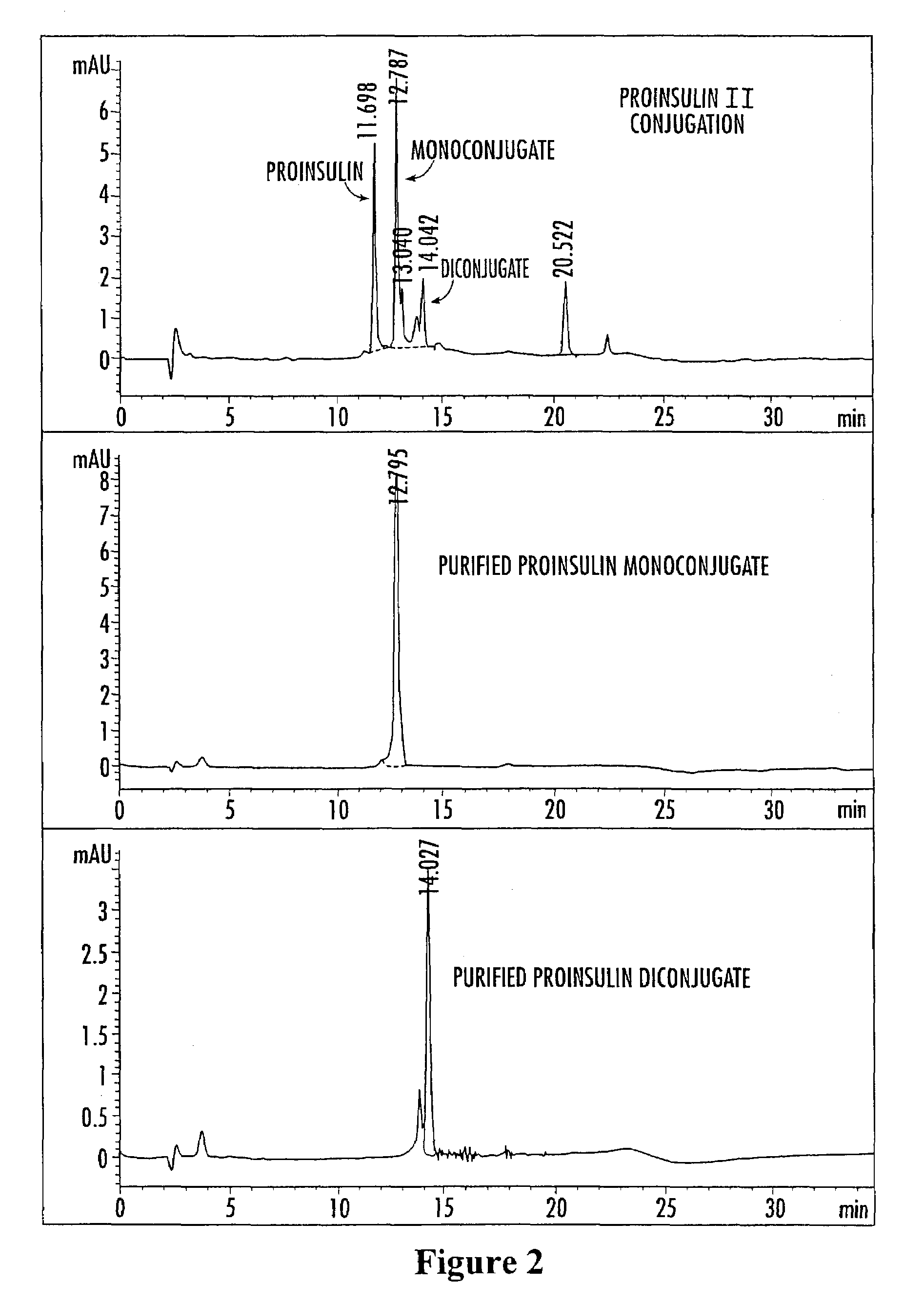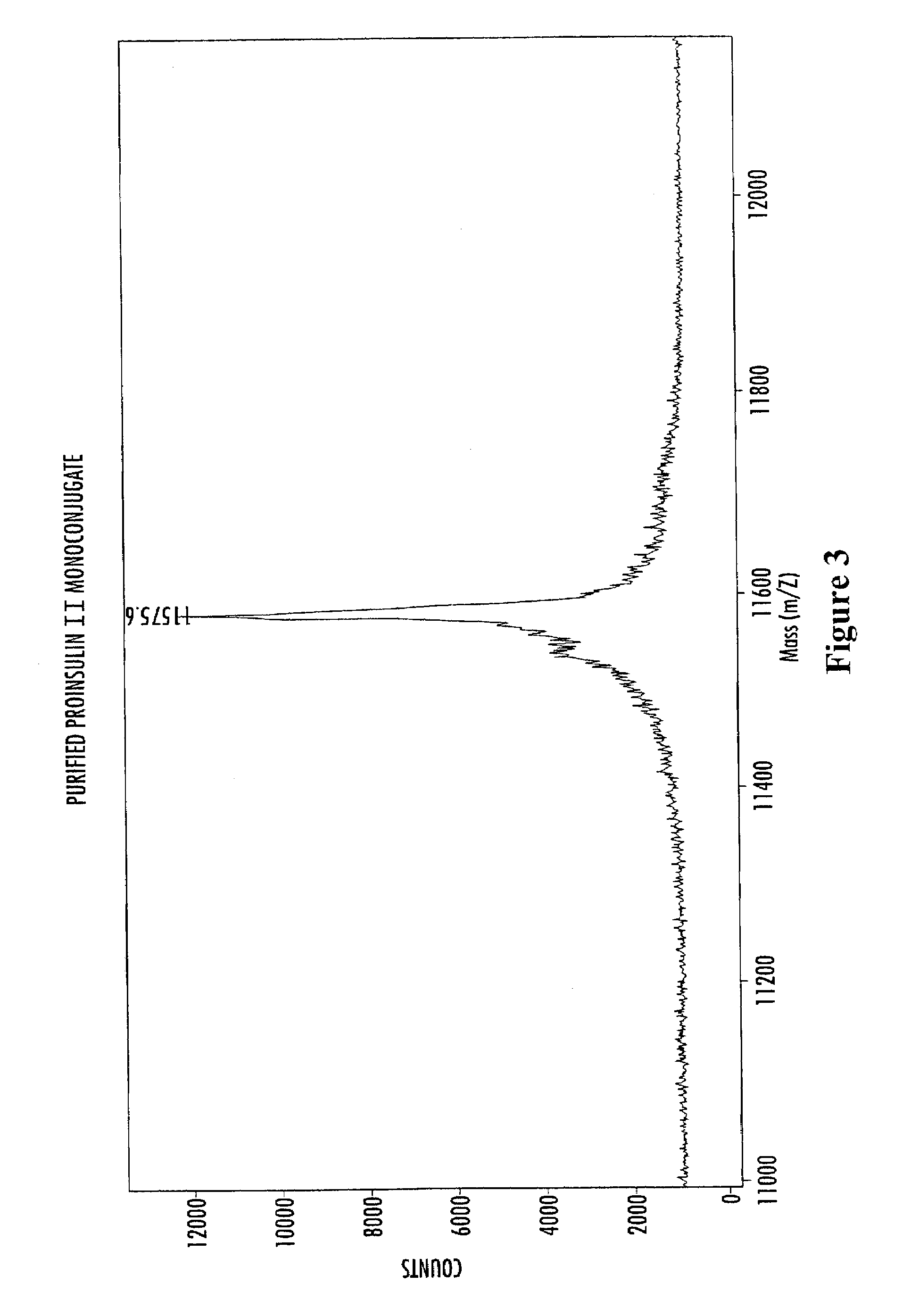Insulin polypeptide-oligomer conjugates, proinsulin polypeptide-oligomer conjugates and methods of synthesizing same
a polypeptide and oligomer technology, applied in the field of conjugates, can solve the problems of biologically inactive breakdown products, insufficient production of insulin, or reducing sensitivity to insulin, etc., and achieve the effect of low cost and/or higher yielding and high site specificity
- Summary
- Abstract
- Description
- Claims
- Application Information
AI Technical Summary
Benefits of technology
Problems solved by technology
Method used
Image
Examples
example 1
Synthesis of 6-(2-{2-[2-(2-{2-[2-(2-methoxyethoxy)ethoxy]-ethoxy}-ethoxy)-ethoxy]-ethoxy}-ethoxy)-hexanoic acid 2,5-dioxo-pyrrolidin-1-yl ester (8)
[0407]Hexaethylene Glycol Monobenzyl Ether (1). An aqueous sodium hydroxide solution prepared by dissolving 3.99 g (100 mmol) NaOH in 4 ml water was added slowly to monodispersed hexaethylene glycol (28.175 g, 25 ml, 100 mmol). Benzyl chloride (3.9 g, 30.8 mmol, 3.54 ml) was added and the reaction mixture was heated with stirring to 100° C. for 18 hours. The reaction mixture was then cooled, diluted with brine (250 ml) and extracted with methylene chloride (200 ml×2). The combined organic layers were washed with brine once, dried over Na2SO4, filtered and concentrated in vacuo to a dark brown oil. The crude product mixture was purified via flash chromatography (silica gel, gradient elution: ethyl acetate to 9 / 1 ethyl acetate / methanol) to yield 8.099 g (70%) of monodispersed compound 1 as a yellow oil.
[0408]Ethyl 6-methylsulfonyloxyhexanoa...
example 2
Synthesis of Activated MPEG7-C8 (14)
[0415]Mesylate of triethylene glycol monomethyl ether (9). To a solution of CH2Cl2 (100 mL) cooled to 0° C. in an ice bath was added monodispersed triethylene glycol monomethyl ether (25 g, 0.15 mol). Then triethylamine (29.5 mL, 0.22 mol) was added and the solution was stirred for 15 min at 0° C., which was followed by dropwise addition of methanesulfonyl chloride (13.8 mL, 0.18 mol, dissolved in 20 mL CH2Cl2). The reaction mixture was stirred for 30 min at 0° C., allowed to warm to room temperature, and then stirred for 2 h. The crude reaction mixture was filtered through Celite (washed CH2Cl2˜200 mL), then washed with H2O (300 mL), 5% NaHCO3 (300 mL), H2O (300 mL), sat. NaCl (300 mL), dried MgSO4, and evaporated to dryness. The oil was then placed on a vacuum line for ˜2 h to ensure dryness and afforded the monodispersed compound 9 as a yellow oil (29.15 g, 80% yield).
[0416]Heptaethylene glycol monomethyl ether (10). To a solution of monodisper...
example 3
Synthesis of Activated MPEG7-C10 (19)
[0421]10-hydroxydecanoate (15). To a solution of monodispersed 10-hydroxydecanoic acid (5.0 g, 26.5 mmol) in ethanol (100 mL) was added H2S04 (0.43 mL, 8.8 mmol) and the reaction was heated to reflux with stirring for 3 h. The crude reaction mixture was cooled to room temperature and washed H2O (100 mL), sat. NaHCO3 (2×100 mL), H2O (100 mL), dried MgSO4, and evaporated to dryness to afford the monodispersed compound 15 as a clear oil (6.9 g, 98% yield).
[0422]Mesylate of 10-hydroxydecanoate (16). To a solution of CH2Cl2 (27 mL) was added monodispersed 10-hydroxydecanoate 15 (5.6 g, 26 mmol) and cooled to 0° C. in an ice bath. Then triethylamine (5 mL, 37 mmol) was added and the reaction mixture was stirred for 15 min at 0° C. Then methanesulfonyl chloride (2.7 mL, 24 mmol) dissolved in CH2Cl2 (3 mL) was added and the reaction mixture was stirred at 0° C. for 30 min, the ice bath was removed and the reaction was stirred for an additional 2 h at roo...
PUM
| Property | Measurement | Unit |
|---|---|---|
| Fraction | aaaaa | aaaaa |
| Fraction | aaaaa | aaaaa |
| Fraction | aaaaa | aaaaa |
Abstract
Description
Claims
Application Information
 Login to View More
Login to View More - R&D
- Intellectual Property
- Life Sciences
- Materials
- Tech Scout
- Unparalleled Data Quality
- Higher Quality Content
- 60% Fewer Hallucinations
Browse by: Latest US Patents, China's latest patents, Technical Efficacy Thesaurus, Application Domain, Technology Topic, Popular Technical Reports.
© 2025 PatSnap. All rights reserved.Legal|Privacy policy|Modern Slavery Act Transparency Statement|Sitemap|About US| Contact US: help@patsnap.com



